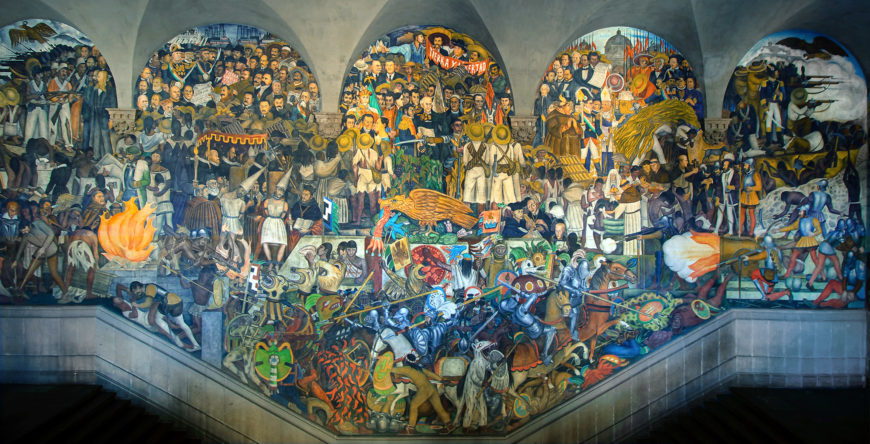
Diego Rivera, “From the Conquest to 1930,” History of Mexico murals, 1929–30, fresco, Palacio Nacional, Mexico City
How is history told?
Typically, we think of history as a series of events narrated in chronological order. But what does history look like as a series of images? Mexican artist Diego Rivera responded to this question when he painted The History of Mexico, as a series of murals that span three large walls within a grand stairwell of the National Palace in Mexico City. In Rivera’s words, the mural represents “the entire history of Mexico from the Conquest through the Mexican Revolution . . . down to the ugly present.”[1]
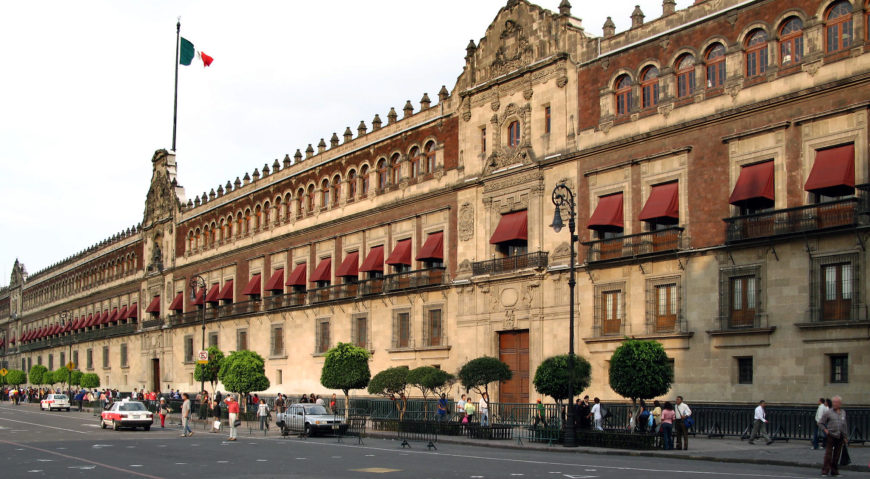
Palacio Nacional, Mexico City (photo: Paula Soler-Moya, CC BY-NC-ND 2.0)
In an overwhelming and crowded composition, Rivera represents pivotal scenes from the history of the modern nation-state, including scenes from the Spanish Conquest, the fight for independence from Spain, the Mexican-American war, the Mexican Revolution, and an imagined future Mexico in which a workers’ revolution has triumphed. Although this mural cycle spans hundreds of years of Mexican history, Rivera concentrated on themes that highlight a Marxist interpretation of history as driven by class conflict as well as the struggle of the Mexican people against foreign invaders and the resilience of Indigenous cultures.
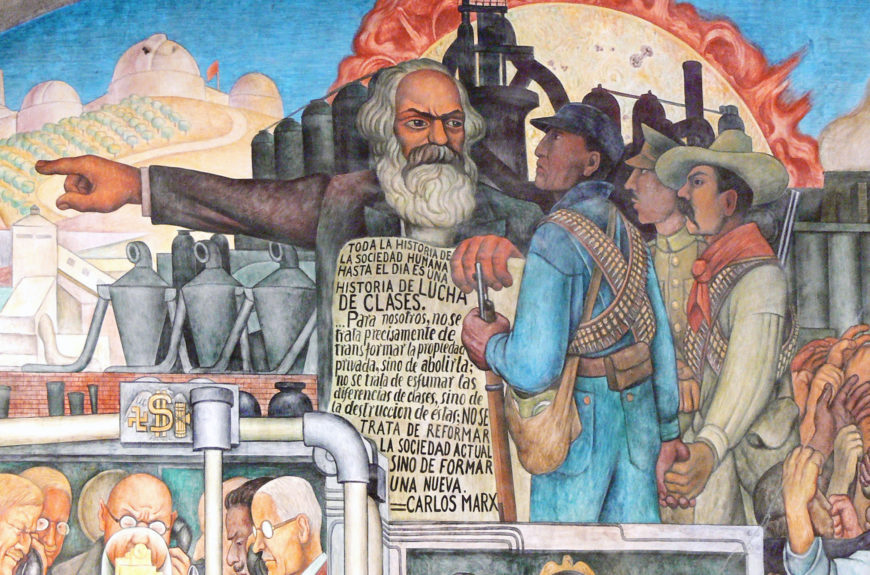
Diego Rivera, “Mexico Today and Tomorrow,” detail featuring Karl Marx, History of Mexico murals, 1935, fresco, Palacio Nacional, Mexico City (photo: Wolfgang Sauber, CC BY-SA 3.0)
A new national identity
In the immediate years following the Mexican Revolution (1910–1920), the newly formed government sought to establish a national identity that eschewed Eurocentrism (an emphasis on European culture) and instead heralded the Amerindian. The result was that Indigenous culture was elevated in the national discourse. After hundreds of years of colonial rule and the Eurocentric dictatorship of Porfirio Díaz, the new Mexican state integrated its national identity with the concept of indigenismo, an ideology that lauded Mexico’s past Indigenous history and cultural heritage (rather than acknowledging the ongoing struggles of contemporary Indigenous people and incorporating them into the new state governance).
José Vasconcelos, the new government’s Minister of Public Education, conceived of a collaboration between the government and artists. The result were state-sponsored murals such as those at the National Palace in Mexico City.
Why murals?
Rivera and other artists believed easel painting to be “aristocratic,” since for centuries this kind of art had been the purview of the elite. Instead they favored mural painting since it could present subjects on a large scale to a wide public audience. This idea—of directly addressing the people in public buildings—suited the muralists’ Communist politics. In 1922, Rivera (and others) signed the Manifesto of the Syndicate of Technical Workers, Painters, and Sculptors, arguing that artists must invest “their greatest efforts in the aim of materializing an art valuable to the people.”[2]
Diego Rivera, History of Mexico murals, 1929–30, frescos in the stairwell of the Palacio Nacional, Mexico City
Rivera had to design his composition around the pre-existing built environment of the National Palace. Rivera painted in the historical buon fresco technique, in which the artist paints directly upon wet plaster that has been applied to a wall resulting in the pigment being permanently fused to the lime plaster. Such murals were common in pre-conquest Mexico as well as in Europe.
In the case of The History of Mexico, this meant creating a three-part allegorical portrayal of Mexico that was informed by the specific history of the site. Today the National Palace is the seat of executive power in Mexico, but it was built atop the ruins of the Aztec emperor Moctezuma II’s residence after the Spanish Conquest of the capital of Tenochtitlan in 1521. The site then served as the residence of the conquistador Hernán Cortés and later the Viceroy of New Spain until the end of the Wars of Independence in 1821. This site is a potent symbol of the history of conflict between Indigenous Aztecs and Spanish invaders.
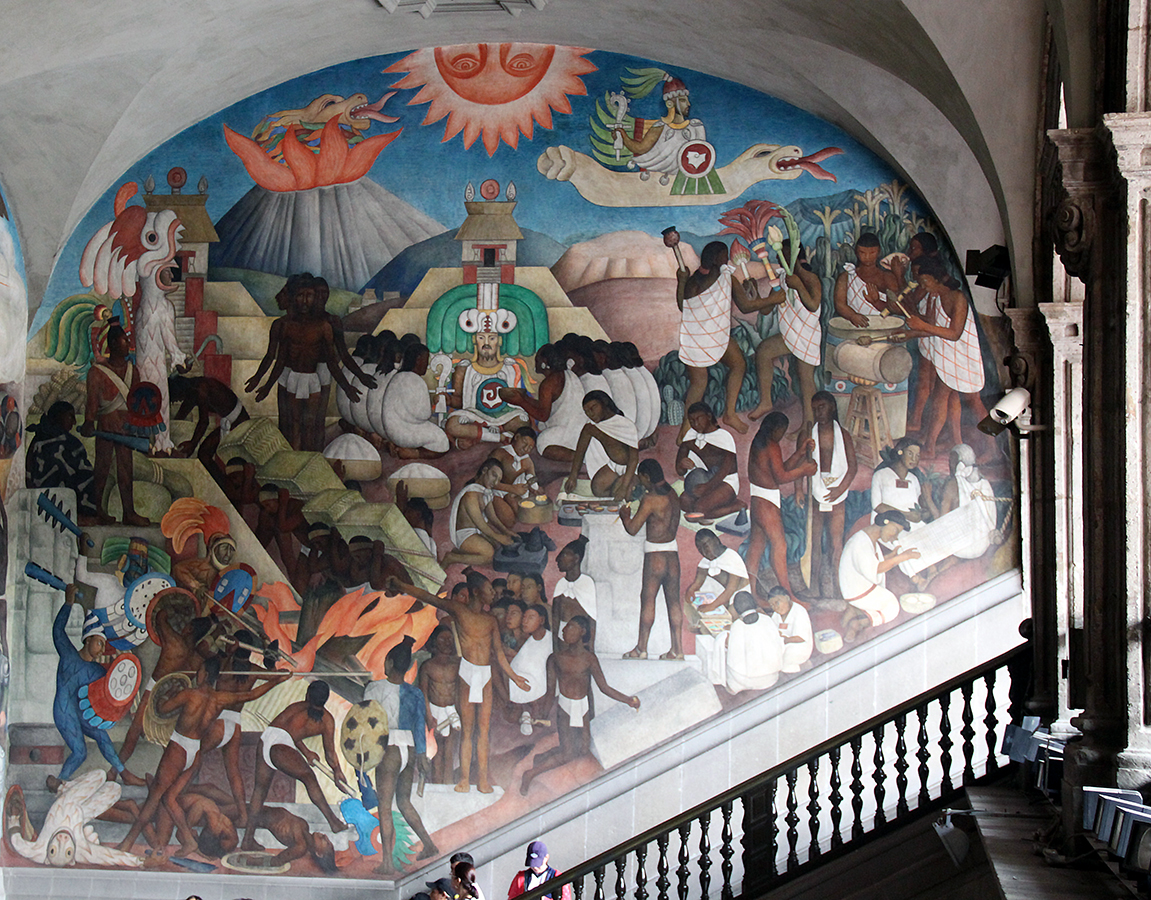
North wall: Diego Rivera, “The Aztec World,” History of Mexico murals, 1929, fresco, Palacio Nacional, Mexico City (photo: Gary Todd, CC0)
The North Wall

Quetzalcoatl, detail, Bernardino de Sahagún and collaborators, Florentine Codex, vol. 1, 1575–1577 (Medicea Laurenziana Library, Florence, Italy)
The Aztec World, the title of the mural on the North Wall, features Rivera’s first large-scale rendering of Mesoamerica before the Spanish invasion—here focused on the Aztecs (the Mexica). Rivera’s representation of the deity Quetzalcoatl (“feathered serpent”), seated in the center of the composition wearing a headdress of quetzal feathers—draws on imagery from colonial-era sources, in particular, an image of Quetzalcoatl from the Florentine Codex.
Against the backdrop of the Valley of Mexico (where Tenochtitlan and now Mexico City are located), Rivera renders a Mesoamerican pyramid and various aspects of Aztec life. He represents figures grinding maíz (corn) to make tortillas, playing music, creating paintings, sculpture, and leatherwork, and transporting goods for trade and imperial tribute.
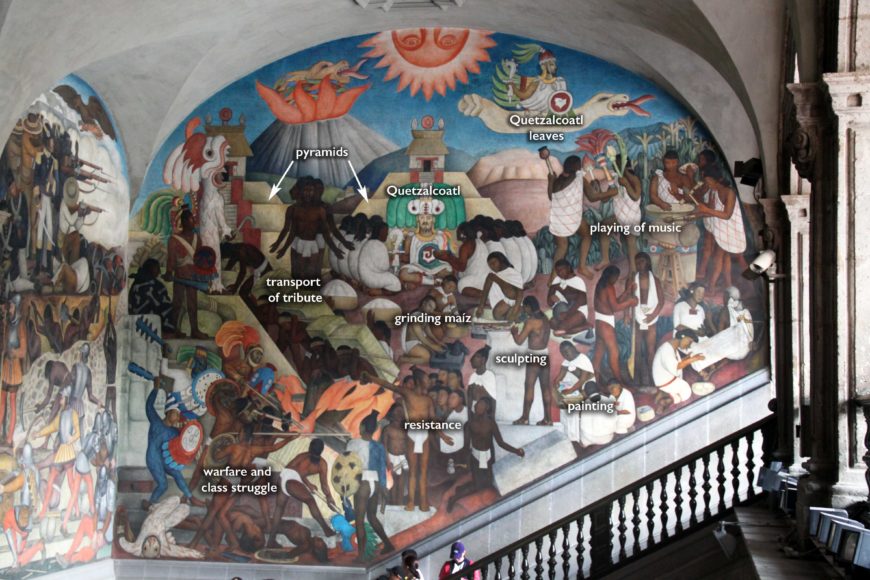
Annotated image of the north wall: Diego Rivera, “The Aztec World,” History of Mexico murals, 1929, fresco, Palacio Nacional, Mexico City (photo: Gary Todd, CC0)
Despite Rivera’s great admiration for pre-Conquest civilizations (he was a great collector of pre-Columbian art) he did not uncritically portray the Aztec world as utopian. In addition to rendering scenes of agriculture and cultural production, The Aztec World shows laborers building pyramids, a group resisting Aztec control, and scenes of the Aztecs waging the wars that created and maintained their empire. Rivera demonstrates the Marxist position that class conflict is the prime driver of history—here, even before the arrival of the Spaniards.
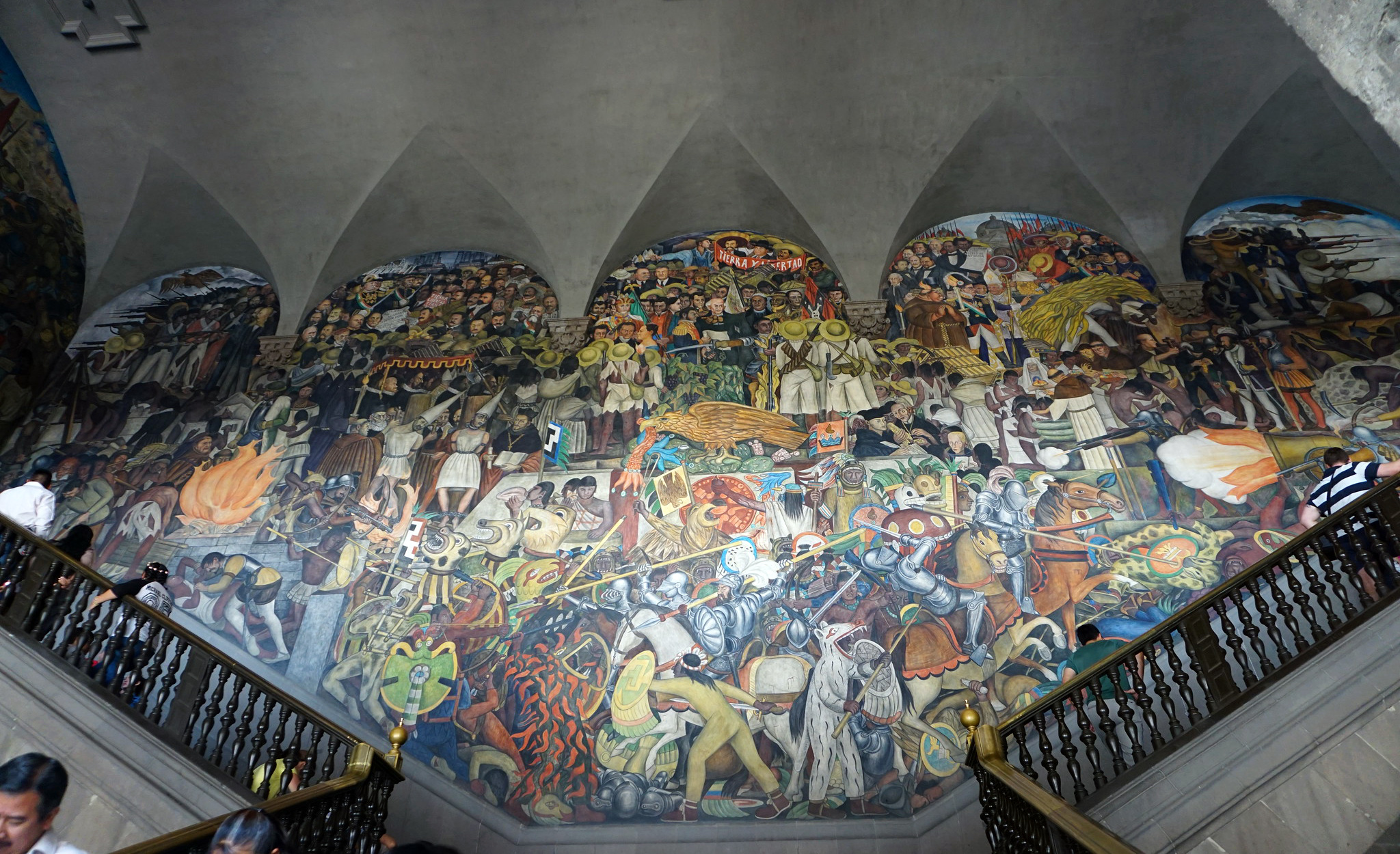
West wall: Diego Rivera, “From the Conquest to 1930,” History of Mexico murals, 1929–30, fresco, Palacio Nacional, Mexico City (photo: xiroro, CC BY-NC-ND 2.0)
The West Wall
On the West Wall and in the center of the stairway, visitors are confronted with a chaotic composition titled From the Conquest to 1930. The wall is divided at the top by corbels from which spring five arches.
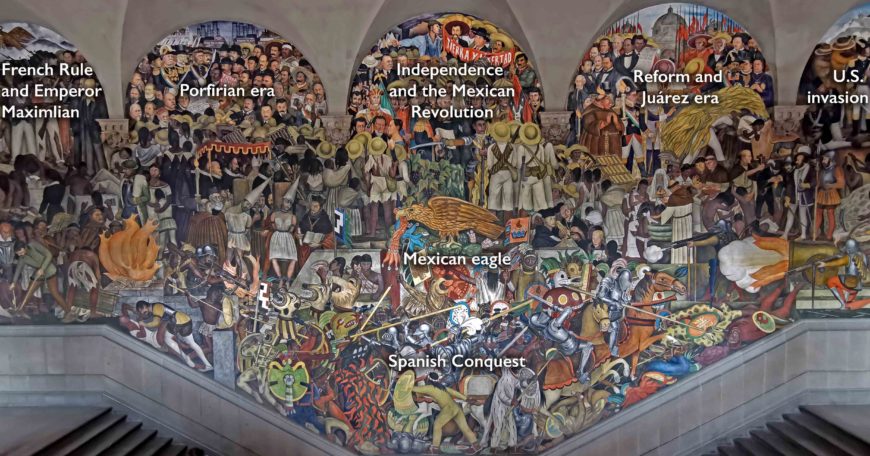
Annotated image of the west wall: Diego Rivera, “From the Conquest to 1930,” History of Mexico murals, 1929–30, fresco, Palacio Nacional, Mexico City (photo: drkgk)
Across the top, In the outermost sections, Rivera represents the two nineteenth-century invasions of Mexico—by France and the United States respectively. From left to right, the three central sections depict: the dictatorship of Porfirio Díaz, figures associated with Independence and the Mexican Revolution, and the Constitution of 1857 (during the presidency of Benito Juárez) and the War of Reform. These historical events are somewhat distinguishable thanks to the arches that separate the scenes.
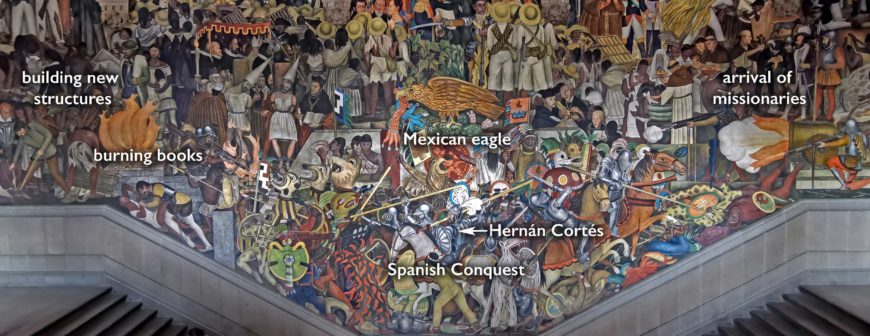
Annotated lower section of the west wall: Diego Rivera, “From the Conquest to 1930,” History of Mexico murals, 1929–30, fresco, Palacio Nacional, Mexico City (photo: drkgk)
In the lower section of the mural however, there is no such distinction between, for example, scenes of the Spanish conquest of the Aztec empire, the subsequent destruction of Mesoamerican painted books (now called codices), the arrival of Christian missionaries, the destruction of pre-Columbian temples, and construction of new colonial structures—emphasizing the interrelated nature of these events.

Eagle on cactus (detail), Diego Rivera, “From the Conquest to 1930,” History of Mexico murals, 1929–30, fresco, Palacio Nacional, Mexico City (photo: Sarahh Scher, CC BY-NC-ND 2.0)
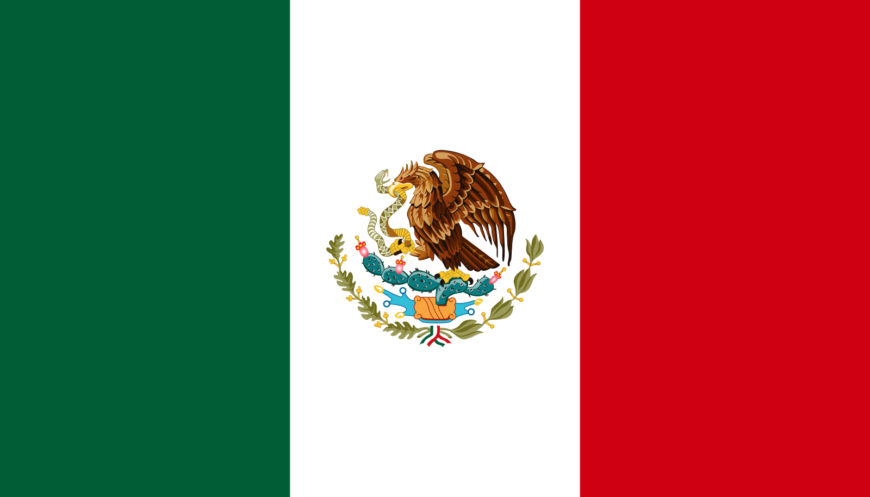
Mexican flag
An eagle standing on a nopal cactus at the very center of the wall, mirrors the insignia at the center of the Mexican flag. These historical scenes have been compressed and flattened on the picture surface resulting in a dense visual mosaic of intertwining figures and forms. The lack of deep space in the composition makes it difficult to distinguish between different scenes, and results in an allover composition without a central focus or a clear visual pathway. This cacophony of historical figures and flurried action overwhelms viewers as they walk up the stairs.
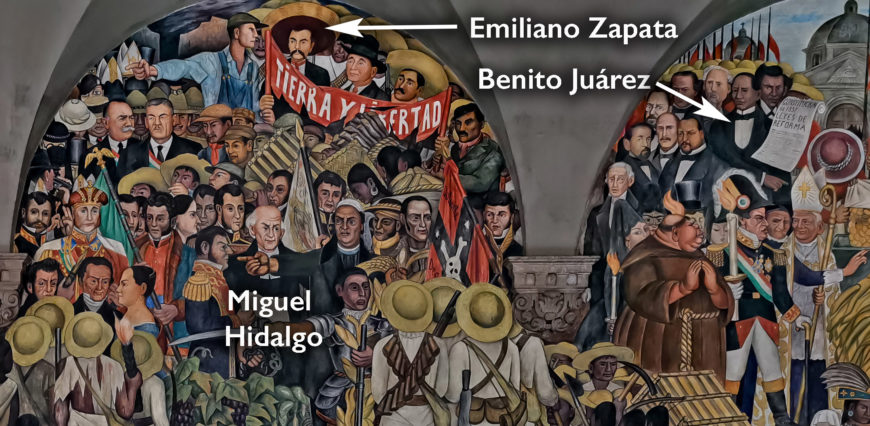
Annotated upper section of the west wall: Diego Rivera, “From the Conquest to 1930,” History of Mexico murals, 1929–30, fresco, Palacio Nacional, Mexico City (photo: drkgk)
Given the breadth of the wall space, Rivera had to make critical decisions about which historical figures and narratives to include. Rivera’s formal choices—the flattening of the pictorial space, the nonlinear organization, and the monumental scale of the figures—create a non-hierarchical composition. These formal choices support Rivera’s decision to represent not just the historically well-known and recognizable figures, such as the independence fighter Miguel Hidalgo, revolutionary Emiliano Zapata (who holds a flag with the words tierra y libertad, or land and liberty), or the first Indigenous president Benito Juárez, but also anonymous workers, laborers, and soldiers. As Rivera later noted,
“Each personage in the mural was dialectically connected with his neighbors, in accordance with his role in history. Nothing was solitary; nothing was irrelevant.”[3]
The artist’s portrayal of the interconnection of social struggle throughout Mexico’s history and the non-hierarchical representation of the historical figures reflects his Marxist perspective.
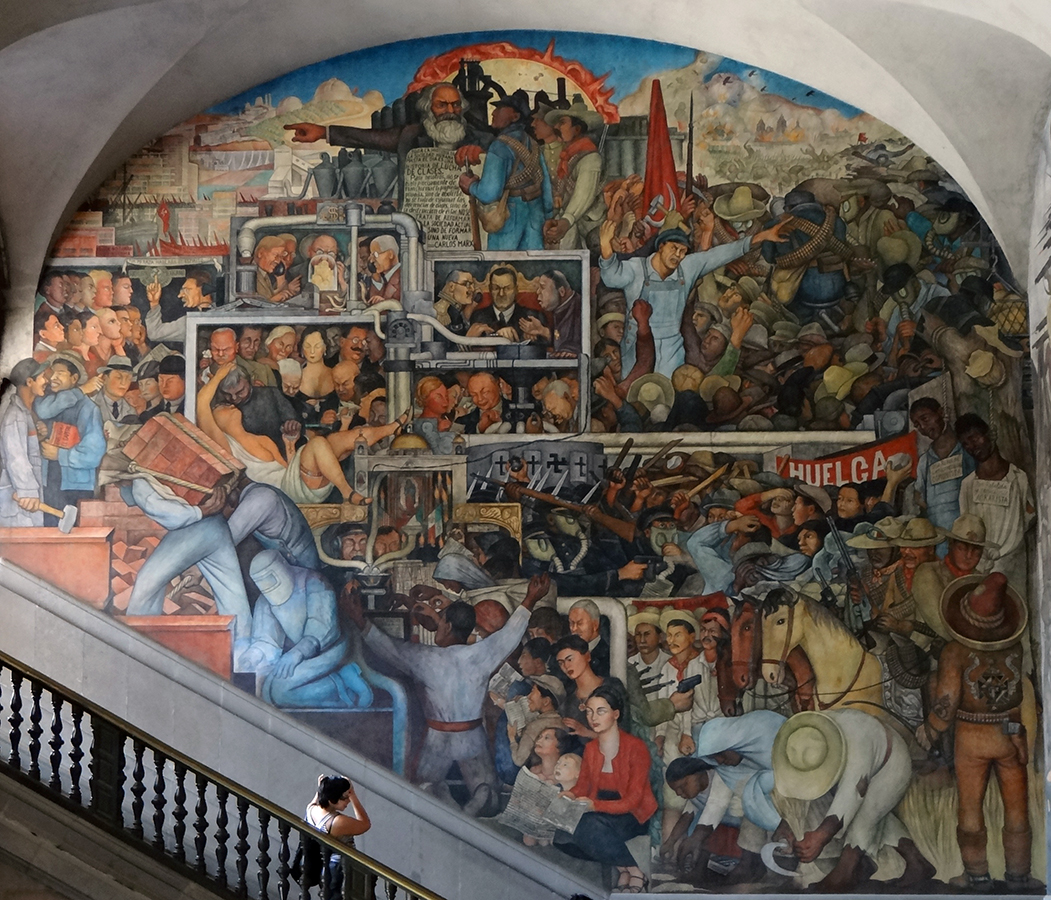
South wall: Diego Rivera, “Mexico Today and Tomorrow,” History of Mexico murals, 1935, fresco, Palacio Nacional, Mexico City (photo: Cbl62, CC0)
The South Wall
Rivera’s politics become more evident on the South Wall, titled Mexico Today and Tomorrow, which was painted years later in 1935. Mexico Today and Tomorrow depicts contemporary class conflict between industrial capitalism (using machinery and with a clear division of labor) and workers around the world.
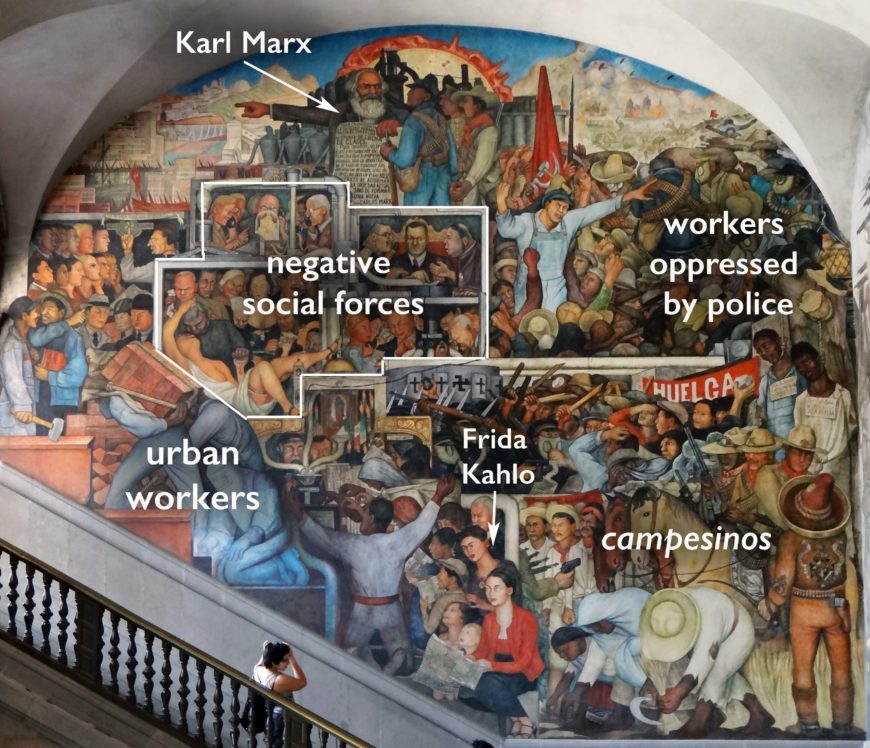
Annotated image of the south wall: Diego Rivera, “Mexico Today and Tomorrow,” History of Mexico murals, 1935, fresco, Palacio Nacional, Mexico City (photo: Cbl62, CC0)
The narrative begins in the lower right and progresses upward in a boustrophedonic pattern (here, a reverse S-curve), similar to the compositional layout of pre-Conquest Mesoamerican painted manuscripts (such as the Codex Nuttall). In the lower section Rivera depicts campesinos (peasant farmers) laboring, urban workers constructing buildings, and his wife Frida Kahlo with a number of school children who are being taught as part of an expansion of rural education after the Revolution.
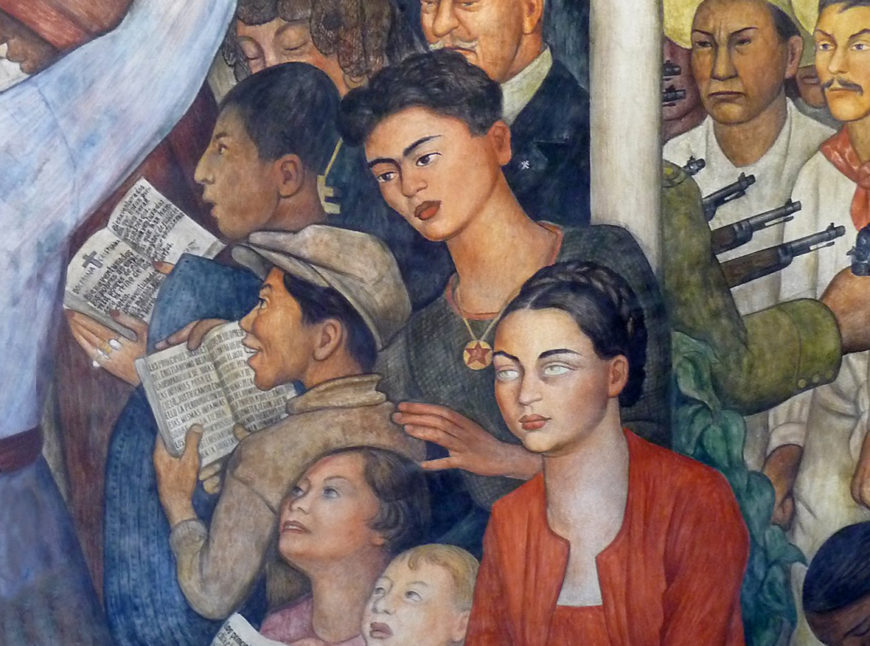
Frida Kahlo wearing a necklace with a red star and hammer and sickle pendant (detail), Diego Rivera, “Mexico Today and Tomorrow,” History of Mexico murals, 1935, fresco, Palacio Nacional, Mexico City (photo: Jen Wilton, CC BY-NC 2.0)
Following the narrative up, Rivera represents—using a pictorial structure unique to this wall—negative social forces such as high-society figures, corrupt and reactionary clergy, and the invasion of foreign capital—here represented by contemporaneous capitalists such as John D. Rockefeller, Jr. who was attempting to secure access to Mexican oil at the time.
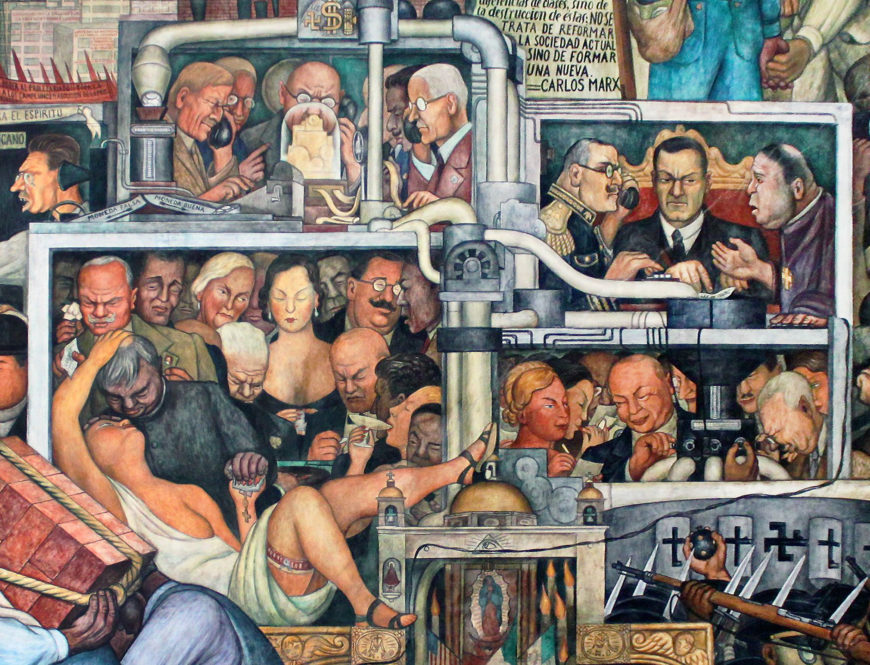
Negative social forces—showing capitalist corruption and greed (detail), Diego Rivera, “Mexico Today and Tomorrow,” History of Mexico murals, 1935, fresco, Palacio Nacional, Mexico City (photo: Carlos Villarreal, CC BY-NC 2.0)
To the right, workers are being oppressed by police wearing gas masks, yet just above this scene a figure in blue emerges from a mass of uprising workers, their fists raised in the air against the backdrop of downtown Mexico City. The narrative culminates in a portrait of Karl Marx who is shown pointing wearied workers and campesinos towards a “vision of a future industrialized and socialized land of peace and plenty.”[4] Unlike the non-linear composition of the West Wall, here Rivera expresses his vision for the future of Mexico, a winding path that leaves oppression and corruption behind.

Diego Rivera, “Mexico Today and Tomorrow,” detail featuring Karl Marx, History of Mexico murals, 1935, fresco, Palacio Nacional, Mexico City (photo: Wolfgang Sauber, CC BY-SA 3.0)
An alternative history
So what type of history has Rivera told us and how did he tell it? Is he the sole narrator? The History of Mexico was painted in a governmental building as part of a campaign to promote Mexican national identity, and yet, the mural cycle is not necessarily didactic. Rivera could have created a much simpler representation of Mexican history, one that directed the viewer’s experience more explicitly. Instead, the viewer’s response to this visual avalanche of history is to play an active role in the interpretation of the narrative. The lack of illusionistic space and the flattening of forms creates a composition that allows the viewer to decide where to look and how to read it. Moreover, the experiential and sensorial act of moving up the stairs allows the viewer to perceive the murals from multiple angles and vantage points. There is no “right way” to read this mural because there is no clear beginning or end to the story. The viewer is invited to synthesize the narrative to construct their own history of Mexico.
Notes:
- Diego Rivera, My Art, My Life: An Autobiography (New York: Dover Publications, 1991), pp. 94–95.
- “Manifesto of the Syndicate of Technical Workers, Painters, and Sculptors,” published in Alejandro Anreus, et.al, Mexican Muralism : A Critical History (Berkeley: University of California Press, 2012) pp. 319–321. Signed by Diego Rivera, Davíd Alfaro Siqueiros, Xavier Guerrero, Fermín Revueltas, José Clemente Orozco, Ramón Alva Guadarrama, Germán Cueto, and Carlos Mérida and published in the journal El Machete in June 1924.
- Diego Rivera, My Art, My Life: An Autobiography, pp. 100–101.
- Diego Rivera, My Art, My Life: An Autobiography, p. 131.
Additional resources
Learn more about Latin American modernisms in a Reframing Art History chapter.
Learn more about Rivera’s murals, including Man Controller of the Universe, Sugar Cane, and the Detroit Industry murals.
Alejandro Anreus, Robin Adèle Greely, and Leonard Folgarait, eds. Mexican Muralism: A Critical History (Berkeley: University of California Press, 2012).
David Craven, Diego Rivera As Epic Modernist (New York; London: G.K. Hall; Prentice Hall International, 1997).
Jean Charlot,The Mexican Mural Renaissance, 1920–1925 (New York: Hacker Art Books, 1979).
Diego Rivera, My Art, My Life: An Autobiography (New York: Dover Publications, 1991).
Leonard Folgarait, Mural Painting and Social Revolution in Mexico, 1920-1940 (Cambridge; New York, NY: Cambridge UP, 1998).
Desmond Rochfort, Mexican Muralists: Orozco, Rivera, Siqueiros (San Francisco: Chronicle Books, 1993).

